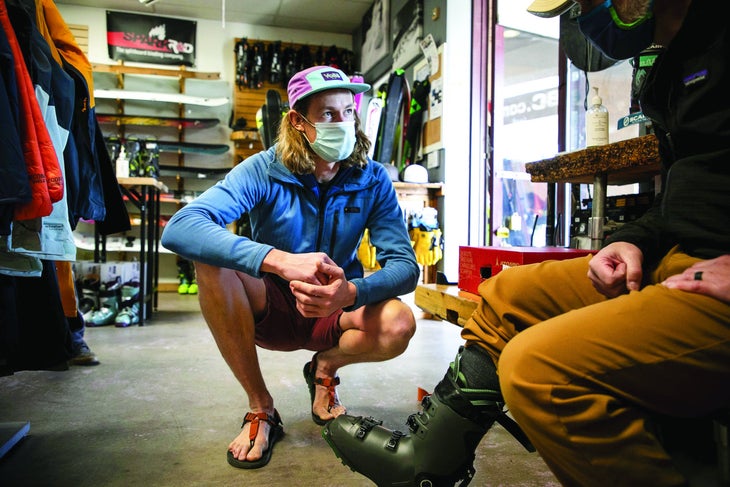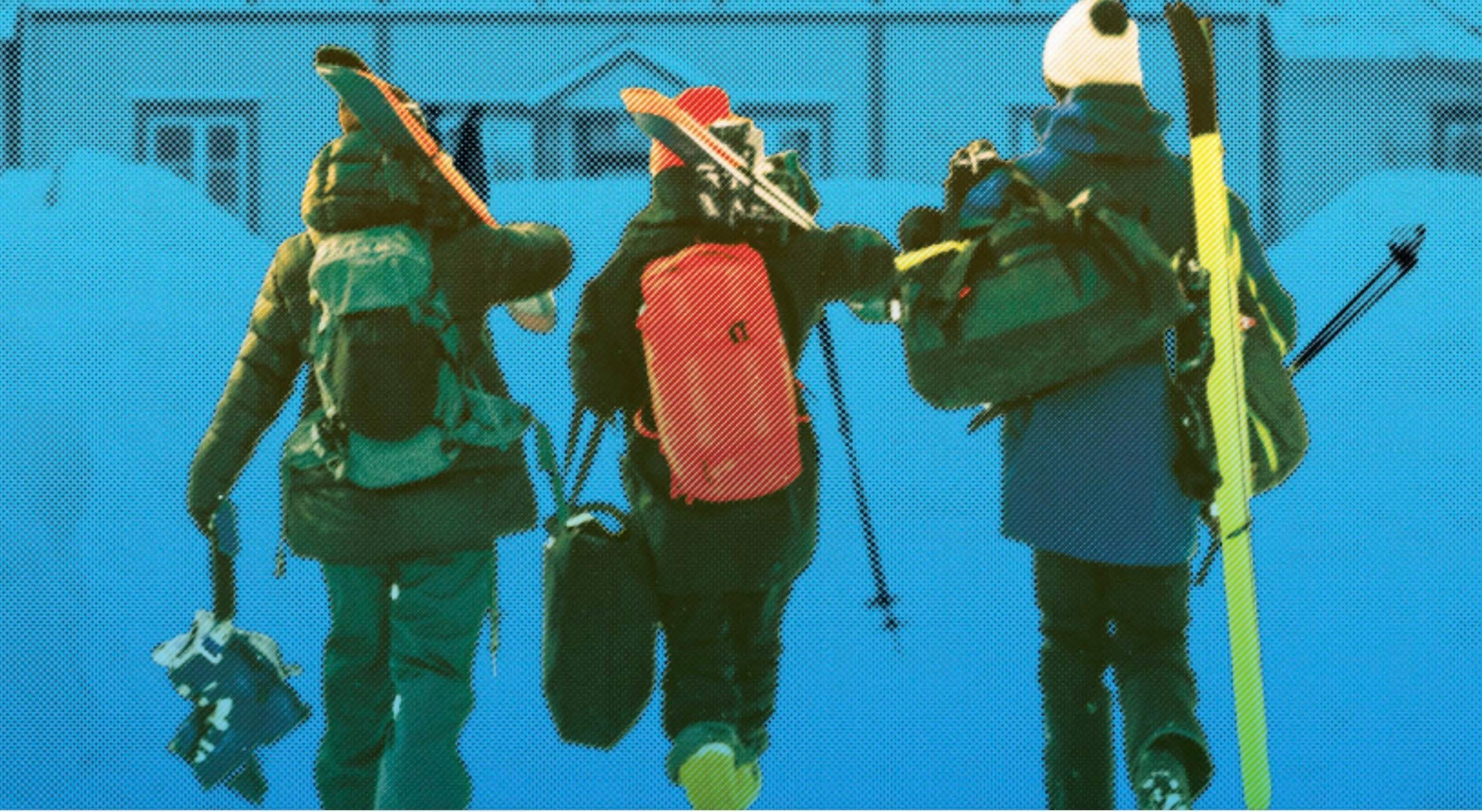Build community. Hire passionate staff. Know your customer.
Everyone understands that these are the keys to a successful specialty retail business. But they’re also easier said than done. So when we called up some of the nation’s most successful shops, we didn’t just ask for their strategies for selling winter gear; we pressed them to divulge the details. Turns out, running a top winter store isn’t complicated—but it does require dedication, long-term strategy, and just plain being a good person.
Read on for inspiration from nine leading retailers across the U.S.
Secret No. 1: Own a Niche
Case study: Outdoor Gear Exchange, Burlington, Vermont
Top-selling winter brands: Salomon, Atomic, Rossignol
Key stat: 50 staffers attended the shop’s employee ski demo day last year.
When Mike Donohue and Marc Sherman added winter gear to Outdoor Gear Exchange (OGE) in the late 1990s, they focused on their passion, telemark skiing. Twenty-five years later, the store has added 140 staff and expanded to just about every category of outdoor gear. Meanwhile, tele sales have plummeted—but Sherman and Donohue never abandoned the sport.
“Telemark might be in decline, but there’s still a dedicated crew,” Donohue said. “They drive from states away to shop here. It’s an annual pilgrimage.”
The draw is expertise. OGE stocks a large variety of telemark gear and employs staff who know the sport and how to service the equipment.
The shop looks for staff with passion and knowledge for tele, and incentivizes them to learn more with demo days and peer-to-peer instruction. That way, the buyers know the best gear to carry, and sales staff can talk minutia with customers.
“If you’re going to sell it, you have to have expertise in the niche,” Donohue said. “Otherwise, it’s wasted stock.”
Secret No. 2: Treat Staff like Gold
Case study: Alpenglow Sports, Tahoe City, California
Top-selling winter brands: DPS, Black Diamond, Arc’teryx
Key stat: The store’s speaker series has raised more than $1 million for local nonprofits.
Nobody wants a revolving door of employees, but figuring out how to retain good people can be a major challenge for retail.
Store owner Brendan Madigan said the reason Alpenglow has such a low turnover—most employees stick around for several years, and the buying team averages 15 years of experience—is a combination of compensation, perks, and culture.
“I want to buck the idea that you can’t make a career at a retail job,” he said. “I’ve always tried to run Alpenglow like a big business.”
That starts with compensating staff at the generous end of the pay scale. Madigan pays as much as he can afford (he declined to share salary numbers), with raises coming at least once a year to keep up with inflation. “Staff don’t need to get rich, but they do need to get paid well,” he said. Perks for full-time employees include matching IRA contributions, flex days, paid vacations, a ski pass, and one annual hardgood product of their choice (he works with reps to offset the cost).
Equally important is making employees feel like they’re part of a team. Everyone is a middle manager, he says, with the power to make customers happy on the fly. “Having responsibility leads to them feeling more invested in the business,” he said. “We give them room to grow and shine.” That’s backed up by veteran staff who are tasked with spreading the company culture to the next generation, which they do through staff ski trips and a speaker series.
The payoff comes in the tough times. Seasoned buyers know which companies are only going to fulfill 60 percent of an order and can make the risky call to buy 140 percent to compensate, or find a comparable product to stock instead.
“A lot of that is by feel,” Madigan said. “You never know if it’s going to work out, but you feel a lot better about it when it’s someone with 15-plus years of experience making [the call].”
Secret No. 3: Take Customer Service to the Next Level
Case study: Cripple Creek Backcountry, Colorado/Washington
Top-selling winter brands: Salomon, Scarpa, Dynafit
Key stat: 95 percent of gear-related appointments end in sales.
Well before COVID normalized shopping by appointment, Doug Stenclik had already seen the advantage of one-on-one experiences for customers, staff, and the bottom line.
Starting in the fall of 2018, Stenclik, the co-owner and founder of Cripple Creek Backcountry, encouraged his staff to skip the classic “walk to the ski wall” sales style in favor of getting to know the customer first. At the company’s six shops in Colorado and Washington State, employees were trained to ask extensive questions about the customer’s motivations and interests before they even began to talk about gear. That evolved into a formalized list of questions, and then, shopping by appointment.
Stenclik said he worried about customer and employee buy-in to this labor-intensive process at first, “but I knew if I could get everyone to commit, [one-on-one appointments were] going to provide the best experience for everybody.”
Appointments became required at the onset of the pandemic. Today, the shops are happy to have people walk in off the street, but about 70 percent of customers still make an appointment and fill out a questionnaire beforehand, either online or over the phone. The questions ask for data like weight and height, but also dig deeper. For instance, people who want a boot for uphill or fitness skiing would provide their boot size and what other brands of boots they own, as well as attach pictures of their feet. The store then matches the customer with an employee who also likes to tour for exercise. Before the customer even sets foot in the store, the assigned salesperson has figured out their best two or three boot options.

The process saves everyone time. Cripple Creek stores work together to share inventory, moving sizes and models around to where they’re needed. When the customer walks in, the salesperson is waiting with the preselected boots. The customer doesn’t have to wait for help because sales staff are busy or come back later because the right size wasn’t in stock.
“We’re closing more sales,” Stenclik said. “If we just said, ‘Here are the only two boots for you to try,’ customers would want to shop around. But because we’re making specific recommendations, based on research, we win them over.” And though staffers were initially skeptical, Stenclik says, three years in, they’re realizing that investing time ahead of the appointment streamlines the overall process, as they don’t have to choose products on the fly, hunt for inventory, or make special orders.
For all, Stenclik said, “the response has been really positive.”
Secret No. 4: Sweat the Details
Case study: Skimo.co, Salt Lake City, Utah
Top-selling winter brands: Dynafit, Scarpa, La Sportiva
Key stat: In 2020, sales doubled over the previous year.
Just based on its name, one might suspect Skimo.co is more than its single retail location. Scroll through the website, and you’ll also discover that it’s much more than an online store. The business’s goal is to educate customers, said James Roh, marketing and content manager. “Our mission statement is to be experts on the topic of backcountry skiing,” he says. “It boils down to getting people into the right gear so they have as much fun as we do.”
That starts with stuffing the website with information. Staffers write blog articles and in-depth gear reviews. There are detailed descriptions of classic ski tours in ten states from staff and customers. A fill-in form helps buyers sort through the confusion of matching boots and bindings. And an entire section compares packs, skis, poles, and more in data-rich charts.
“We’re a bunch of gear nerds,” Roh said. “We weigh and measure everything that comes in the door.”
All those resources play a role in attracting online customers, who make up about half of Skimo.co’s business. But they also drive in-person sales. “Many people come into the store for the first time after using our website as a resource for years,” Roh said. He often sees staff and customers referring to the website on the store floor, going over the different options and comparing specs.
It’s a lot of work keeping the site up to date, but Roh said it’s key to their success. “Only a few customers are interested in that much detail,” he said. “But our attention to the details shows we’re a resource and the place to go for backcountry ski gear.”
Secret No. 5: Figure Out What Your Community Needs
Case study: Bill Jackson’s Shop for ���ϳԹ���, Tampa, Florida
Top-selling winter brands: Obermeyer, Spyder, Salomon
Key stat: Ski-related sales declined in 2021 by about 40 percent (because there were no ski club trips)
This South Florida shop played a big part in building the area’s surprisingly large ski community. But co-owner Darry Jackson knows that nurturing that community requires more than a few movie nights—it means getting people to join the club, literally and figuratively.
“You don’t need a ski club if you live in Denver,” said Jackson. “But it’s harder to go skiing from Florida, so clubs are huge here.” Tampa Bay is home to four ski and snowboard clubs, and the largest has more than 4,000 members. Cultivating relations with these clubs has been an essential part of the Jackson family’s business success.
Jackson’s parents started the shop as an army surplus store after World War II and, when they noticed people coming in to buy jackets for skiing in the 1950s, they began carrying ski apparel. By 1970 they were stocking skis. Around the same time, a ski club president noted Jackson’s and his brother’s growing reputations as outdoor guides (they’d been leading scuba diving trips to the Caribbean). He asked Jackson to run a club trip to Buttermilk resort in Aspen, Colorado. It kicked off both Jackson’s passion for skiing and an ongoing relationship with the local ski clubs.
Jackson started holding his pre-trip meetings in the store’s classroom, then offering space to other ski club leaders for planning sessions, annual parties, and board meetings. Although he doesn’t lead trips anymore, Jackson thinks it’s important for the store to stay involved. “I try to go to all of their meetings and parties,” he said. “As years go by, the leadership with any club keeps changing, and [the shop] must maintain a personal relationship with all of them.”
Each club organizes up to 20 trips a year with around 20 people each, plus a couple of parties of 150 or more. Jackson extends store hours to accommodate the meetings. “Because everybody is too busy talking and socializing, we don’t sell as much as you’d expect with several hundred people in the shop,” he said. But he knows they’ll be back.
Secret No. 6: Invest in Vendor Relationships
Case study: Peace Surplus, Flagstaff, Arizona
Top-selling winter brands: Kühl, The North Face, Cotopaxi
Key stat: The store sold two miles’ worth of toboggans in 2o21.
Like just about every other outdoor store last winter, Peace Surplus struggled to keep up with the demand for items like gloves, goggles, and helmets. But when many others couldn’t restock shelves, founder Steve Chatinsky leaned on 40 years of goodwill. As a result, he was getting fresh orders all the way through the pandemic.
“I had the right connections and relationships to find the products I needed,” Chatinsky said. Instead of calling his sales reps, he went right to the top, talking to national sales managers or even company presidents. They were willing to not only take his call, but also jump through hoops for him, searching inventory, scouring warehouses, and rushing shipping, because Chatinsky had been there for them.
After he founded the shop in 1973, Chatinsky made sure he treated sales reps, suppliers, competitors, and the greater outdoor industry really well. He did the simple things, like pay his bills on time. But he also bought products that reps really wanted him to, even when he wasn’t that keen. “When you throw them a bone, they notice,” he said. He became a member of buying groups, like Grassroots Outdoor Alliance and Nation’s Best Sports, and supported them by joining committees and attending their seminars and shows. On his morning walks, he often stops by the other outdoor stores in Flagstaff to shoot the breeze. The local REI sends customers to Peace Surplus, he said.
“The outdoor industry is a small industry,” he said. “People notice if you’re a good person.”
Without all that time and effort, going over his sales reps’ heads last winter probably would have backfired. “If I was pushy and arrogant, I would have pissed people off and ended up at the bottom of the ladder,” Chatinsky said. “I was a good person, and last year, it paid off.”
Last November, Chatinsky sold Peace Surplus but agreed to stay on to help the new owners get started. His first lesson: investing in relationships has real value.
3 More Secrets
Case study: Sunlight Sports, Cody, Wyoming
Keep newbies warm: If a rookie comes in looking to rent skis, staff will start by talking about the importance of good socks and gloves. “When you start with ‘This is how to be warm and comfortable,’ you’re ensuring they’re going to have a good time,” said co-owner Wes Allen. “That’s a known formula for success. They’re going to trust us and come back.”
Case study: Lahout’s, multiple locations, New Hampshire
Follow your customers: This 102-year-old ski shop could have stuck with skis, but when the staff noticed more people coming to northern New England for year-round recreations, it added seven more locations that sell summer gear, too. “Now we see the same skier four or five times a year, instead of just in the winter,” said Anthony Lahout, co-owner and grandson of the founder.
Case study: ���ϳԹ��� Brands, multiple locations, Georgia
Use trips to boost sales: When customers book a guided kayak or boat trip through ���ϳԹ��� Brands, they get an email with detailed info on how to dress for winter excursions and a 15 percent discount code to gear up in one of the shops. “The retail team is trained and knowledgeable about the experiences,” said CEO Mike Overton. “It helps build our clientele and has been really successful.”


